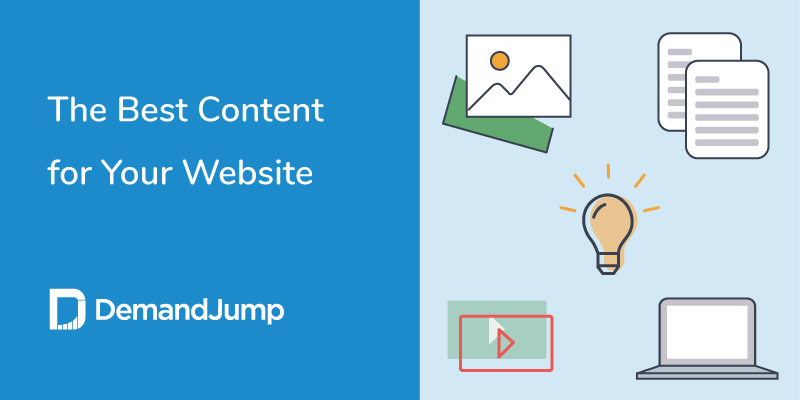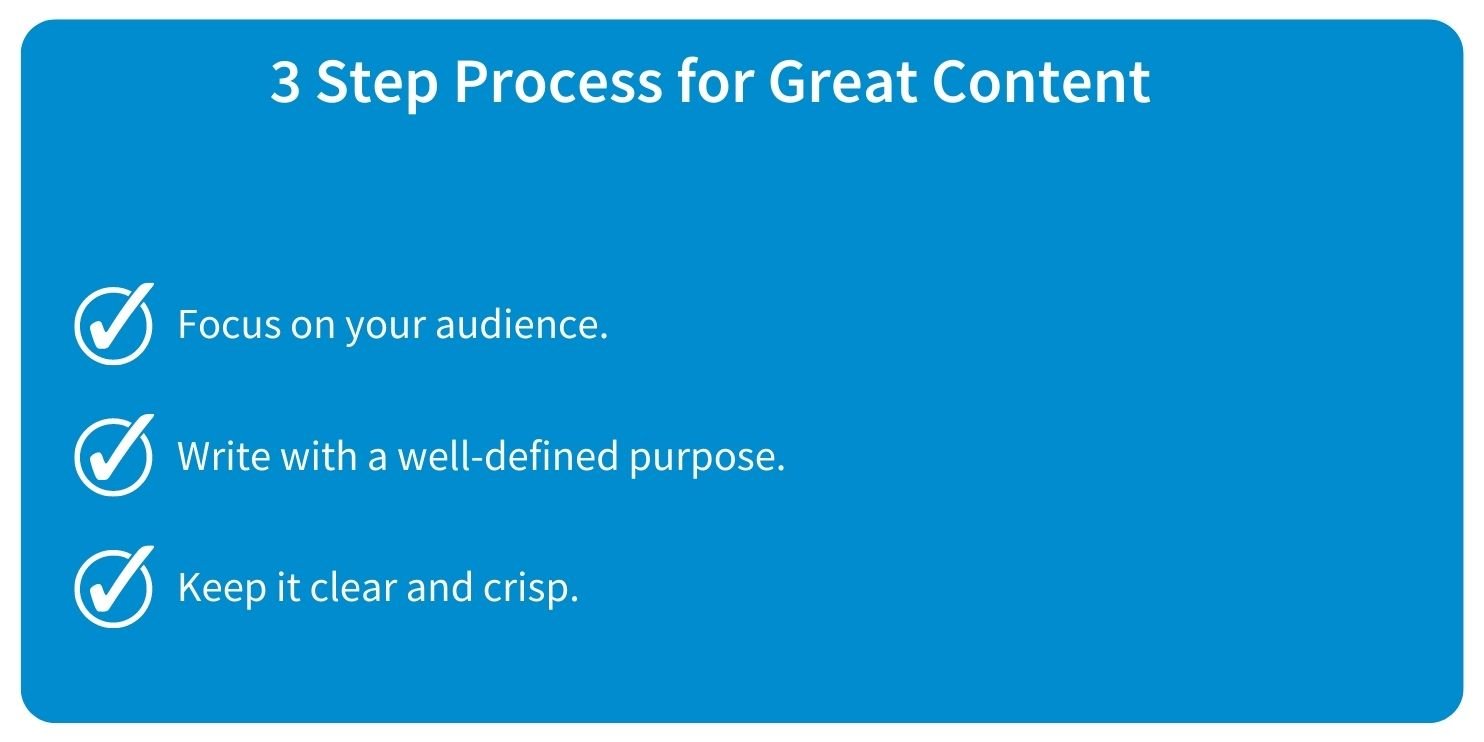Best Content for Websites: 3 Step Process For Great Website Content
July 14, 2021 •Drew Detzler

Website content is critical to the success of your business. The best content for your website is content that informs your audience about what your company does. It educates readers about how you can solve their problems. Most importantly, it answers the questions your audience is asking.
Creating valuable and relevant content for your website also helps you in search engine results, which increases traffic to your website. With well-written and well-structured website content, you can generate qualified leads and convert visitors into customers.
Creating Good Website Content: The 3 Step Process
Every piece of content you create for your website must answer these questions: Who is it for? Why are you writing it? How should you create it?

1. Who Is It For?
Always keep in mind what a specific piece of content is for. You should know who your audience is and create your content specifically for them. If you're selling pet supplies, your audience is pet owners. If you're selling cybersecurity software, your audience is cybersecurity professionals. Answer the questions they are asking.
However, your audience isn't one homogenous category. To differentiate among various segments of your market, create buyer personas. These are fictional representations with detailed descriptions representing each of your audience segments. Gather information about:
- Age
- Income
- Location
- Interests
- Challenges
- Life stage
- Communication preferences
This will help you create even more specific pieces of content, truly answering the questions your target market is asking.
2. Why Are You Writing It?
You should have a clear goal for every piece of content you write. Do you want to inform your audience on a subject? Compare your services to competitors? Show your customers how to use your products? Get them to buy?
Good website content has a well-defined purpose. It's important to narrow down the focus of each piece of content you create. It helps you map your content against a specific stage of the sales funnel. This is the journey your target market goes through on the way to becoming customers. For every piece of content you create, you should define where it fits in the sales funnel.
- Awareness
- Interest
- Consideration
- Intent
- Evaluation
- Purchase
3. How Should You Create It?
The best website content provides value to your audience. It can be long-form content that's comprehensive or it can be punchy and persuasive short pieces. It's important that you write clear, crisp copy. Write short, simple sentences. Avoid jargon and corporate lingo. Illustrate what you mean. And optimize everything using meta titles and descriptions, header tags, and relevant keywords.
Keep in mind that there are essential elements to good website content. Follow these guidelines:
- Write a compelling headline.
- Grab people’s attention with your introductory paragraph.
- Use an outline that flows logically.
- Make your text scannable using headers and bullets.
- Incorporate mixed media like graphics, photos, and videos.
- Include a clear call to action (CTA).
What are the Basic Contents of a Website?
Let’s take a step back and look at the website as a whole. The basic contents of a website are both informational and relate to the layout. Here is the information you need to be sure to include:
- A clear description of your business, your offerings, and your values.
- Easy-to-find contact information, including phone number, address, and contact email.
- Customer testimonials from past and present clients (with their permission).
- An obvious call-to-action, like “book now,” “contact us,” or “get in touch.”
How you decide to set this information up is your decision, but an easy-to-navigate website is essential to outperform the competition. It takes a visitor around 0.05 seconds to form a first impression of your website, and 94% of their judgment is design-related. If they see something that’s messy and confusing, and they can’t find the information they need, they will make related assumptions about what it is like to do business with your company.

So how can web design support your ability to convey the key information in a way that attracts potential customers to you and inspires their curiosity? Here are a few tips:
- The first headline on your homepage should clearly and succinctly tell users about what you offer. Keep it focused on what your products or services mean to your customers and can help them achieve—not your own ideas.
- Subheadings on the page can convey more about your values and what makes you unique. Speak to the pain points that drew the user to your site, and how you solve them better than anyone else.
- Several calls-to-action should also be present on the homepage. These can direct users to different areas of the content funnel where they can get more educated about your business and grow confidence to make a buying decision.
- Your homepage should include a supporting image that sets the tone. Do you want to seem warm? Professional? Funny? Authoritative? Picking the right image helps you convey these emotions without needing a lot of text.
- Show off a little on the homepage, whether it’s featuring your awards, creating space for customer testimonials, or explicitly listing the benefits and features that make you special. Just remember to keep it focused on the needs of your audience and avoid jargon that might get them confused.
As you can see, there is more to website content than your blog, although, your blog is an important piece of it. There is more to website content than text. The best content for your website is a combination of text and multimedia.
Here is some text-based content you can include on your website.
- Brand pages
- Product pages
- Product guides
- Sales pages
- FAQs
- Blog posts
- Case studies
- Research reports
- Customer testimonials
- Interviews
- Press releases
- Media coverage reports
You can also create or integrate different kinds of media for your website, such as:
- Infographics
- Product photos
- Team photos
- Videos
- Podcasts
- Online tools
The Different Types of Website Content Writing
There are different types of content writing. Website content is a major category. Others, such as email and social media posts, also play a key role in your overall marketing and communication strategy.
- Brand content. This includes all your corporate pages, such as your company profile, history and milestones, team bios, customer testimonials, career section, and press releases.
- Blog. There are different types of content you can create for your blog. You can write how-to articles, interviews and Q&As, product guides, competitor comparisons, listicles, tips, best practices, and checklists.
- Product pages. If you have an e-commerce store, you should have product descriptions and checkout pages. Otherwise, you create pages detailing your products or services along with a CTA or lead form.
- Landing pages. These long, detailed pages either capture leads or generate sales. Use landing pages to describe the pain points of your customers, offer the solutions you're providing, outline testimonials of your customers, give answers to possible objections, and list the price and value you're offering.
- Support pages and documents. You can create FAQs, a knowledge base, and a contact page for customers to get support. You may also include product manuals, technical documents, and how-to videos in the mix.
- Long-form content. If you want to establish thought leadership, you back it up with authoritative, long-form content on your website or make it available for download. This includes research reports, case studies, whitepapers, and e-books.
- Email. This is a specialized form of content writing that covers different stages of the sales funnel. Create drip campaigns to move email subscribers toward a purchase. Send out promotional email campaigns to generate sales. Craft transactional emails to confirm orders or upsell products. And write newsletters to nurture loyal customers.
- Social media posts. Creating content for social media is unique. Create short, attention-grabbing copy. Be sure to use striking visuals and compelling videos to engage people.
- Scripts. With the rise of videos, podcasts, and webinars, consider creating this type of content to incorporate into your website. This requires writing scripts purposefully written for this kind of media.
What Type of Content Is Most Popular?
The three most popular and effective types of content writing are case studies, pre-produced videos, and eBooks or whitepapers that prospective users can download and read, according to a 2018 study by the Content Marketing Institute. Once you’ve created a website to be proud of, it’s time to fill it in with content of these types.
Of these most popular content types, marketers that were surveyed for the study said that eBooks/whitepapers were the most effective at driving conversions and generating new business. That is because these long-form pieces of content are located at the bottom of the marketing funnel, educating customers in-depth about the exact benefits and outcomes they will gain by choosing you over the competition. Putting these pieces behind a form is a great way to gain contact information and other insights about potential leads.
Though case studies are very popular and necessary to create, they are less effective at converting new business in and of themselves, because they are located closer to the top of the funnel. A case study is a storytelling summary of a client relationship or project where your services or product have led to success. While this content will get potential customers interested in learning more, it’s not as likely to convince them to buy all on its own.
Though videos are the most-consumed content on the Web, they don’t show up as either effective or ineffective in the study. While you might want to eventually create some videos to meet user expectations and engage different types of audiences, this may be best prioritized as an evolution of your content strategy, not its foundation.
Tools for Content Writing
Defining which content is best for your website requires an understanding of your audience, keyword research, and a close evaluation of your competition.
The good news is, you can gain all those insights with DemandJump. DemandJump automates content strategy, keyword research, and competitor analysis.
Simply type in the topic you want to rank for, and the platform shows you where you are losing to competitors, and a prioritized list of the exact pieces of content to create.
Our product not only helps you decide on website content ideas more easily but also rank and perform better at the end of content production. Get started writing content that ranks, today!
Featured Articles
Categories
- Attribution Tracking (13)
- Channel Optimization (11)
- Consumer Insights (68)
- Content Marketing (251)
- Data Science (8)
- Digital Marketing (6)
- Digital Transformation (26)
- Enterprise (10)
- Lead Generation (14)
- Market Intelligence (8)
- Marketing Analytics (39)
- Marketing Attribution (57)
- Marketing Management (153)
- Marketing Operations (86)
- Organic Search (222)
- Paid Search (52)
- Pillar-Based Marketing (63)
- Programmatic Advertising (9)
- SaaS Content (14)
- SaaS Marketing (29)
- Search Marketing (111)
- SEO Keyword Research (28)
- SEO Pillar (18)
- SEO Strategy (46)
- SMB (5)
- Website Content (12)


